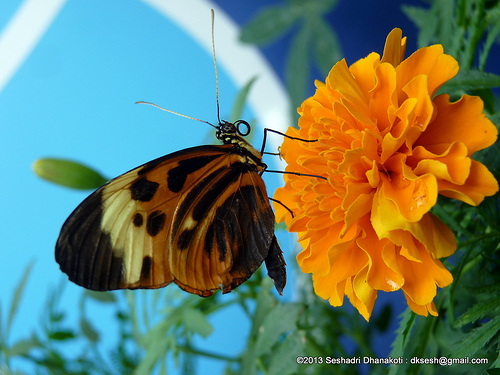The Butterfly House at the National History Museum
When you think of the National History Museum, you may well think of exhibits of dinosaur bones and animals that are no longer alive. Every summer in recent years, however, the museum has put together an incredible exhibit featuring real, living butterflies in a special, climate controlled tent on the museum’s lawn. Designed to replicate a natural tropical environment which the butterflies love, stepping inside the butterfly house is like going from the normal London summer air into a beautiful environment full of fruits and flowers with hot, wet air and a vast array of stunning butterflies which rest on flowers and leavers, flutter through the air, and may even alight on you!

Full Life Cycle
The butterflies that fill the exhibit are flown in to Heathrow airport in their chrysalis state from tropical locations all over the world each summer. These chrysalises are then carefully attended to by the museum’s lepidopterist (that is the fancy name for a butterfly expert) Luke Brown. He cares for the chyrsalises and helps ensure that as the butterflies begin to emerge, they have the best chance of survival. He is very good at his job, too – in the wild only around 10% of butterflies survive from being caterpillars through to adult butterflies, but under his careful attention, 85% of the chrysalises brought to the museum result in living, healthy butterfly specimens. You may, when you visit, even get to witness a new butterfly emerging and flapping its wings for the very first time.
Great For Kids
The Natural History Museum is always a fun place to visit with kids because their imaginations tend to be fuelled by things like the enormous dinosaur skeletons held in the main building. With the addition of the summer butterfly house from May through to September, however, it becomes an even nicer idea for a summer day out in London. While most children love simply to look at the butterflies and experience the tropical environment inside the butterfly house, which even on the most humid of summer days in London is very different from what it is like outside on the lawn, the museum also provide additional things to help them learn more about the creatures. There are games, talks, quizzes and activities aimed at children of different ages that can teach them about how butterflies develop, their lives, how their bodies work, and their unusual senses.
It is worth considering, however, that the butterflies are very delicate and often land on the ground, so if you have a young toddler it is best to carry them so they don’t tread on the butterflies. It is also a good idea to talk to young children before entering about how fragile the butterflies are, and how if they land on them they should not try and touch them.
Visiting the butterfly house at the National History Museum in South Kensington is a really pleasant and relaxing thing to do, that can also be very educational for kids and adults alike.

